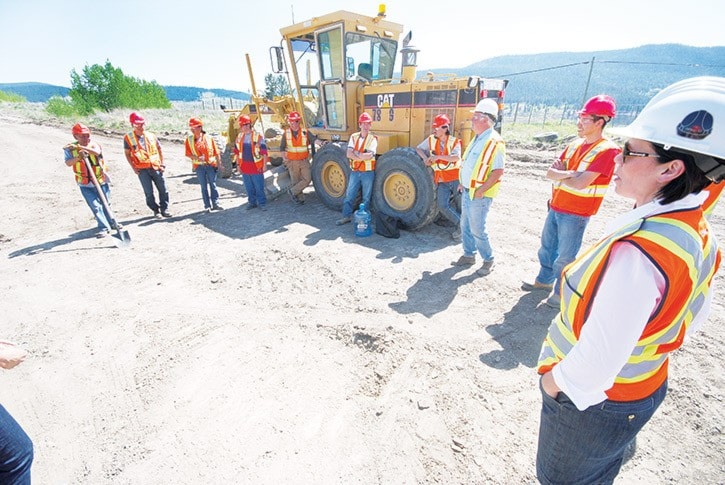Work being done by students enrolled in a heavy equipment operator program near Williams Lake is helping with a future development.
“The reality is that this is a training exercise that ties in with our Coyote Rock subdivision development plans,” said Williams Lake Indian Band economic development officer, Kirk Dressler. “What’s taking place is a heavy equipment operator’s program that is sponsored by the British Columbia Aboriginal Mine Training Association, Thomson Rivers University and the WLIB.”
Students are helping install the booster system for water, explained WLIB Chief Ann Louie. “We completed the main system and are putting in the booster system now for the development.”
Louie said potentially within 25 to 30 years, there could be 90 residential lots at the development site.
“There are 11 large commercial development sites as well,” Louie added.
The British Columbia Aboriginal Mine Training Association (BCAMTA) Heavy Equipment Operator (Civil and Mining) Program is intended to give practical experience to aboriginal persons who are seeking employment opportunities in mining or other industries.
The program includes a classroom and practical component with elements that include training in construction, equipment operation, traffic control, First Aid, and WHMIS. BCAMTA anticipates there will be multiple intakes at the Coyote Rock site.
Presently there are 20 students participating in the second set of training sessions.
“They’ve completed one set and are doing another one,” Louie explained.
“The training is geared toward working in mining, but the expertise they achieve in the program gives them the opportunity to get into almost any employment.”
Students hail from the 15 bands in the region, including some from areas as far away as Smithers.
Recently a student told Louie his lifestyle had been very negative until he entered the program.
“He thanked me for bringing BCAMTA to Williams Lake and encouraging the training within our band because it had changed his life style. Even if we make a change in one individual’s life it’s great.”
Louie said WLIB has been involved with BCAMTA right from the very beginning.
Len Jackson, director of operations for BCAMTA, said typically there are two full-time instructors through TRU Kamloops, but this time they’ve done something completely different.
“There’s an actual contractor on site, IDL Construction, with the building of the roads and the commercial construction. They are providing an on-site supervisor to assist the TRU instructor and to oversee the actual construction of what the WLIB is wanting to have occur on site,” Jackson said.
“Normally a mining partner will give BCAMTA an area at a mine and the students will simply move dirt, whereas this time we spoke to the band to see if there was something that we could do for them, and this is what we landed on.”
The work being done at the Coyote Rock Development area as part of the HEO program will form the initial phases of WLIB’s subdivision development, which will be in construction over the next two or more years.
More than 10 acres of land fronting the Coyote Rock Golf Course will be devoted to highway commercial development, and there will be a multi-phase golf course residential development adjacent to the existing Lexington subdivision.
“It’s a big thing having this development ongoing,” Louie said. “It’s been a big year for us. We got Newsmaker of the Year with the Chamber of Commerce for our work with Mount Polley, and we have since signed another agreement with Taseko Mines.”
In January 2012, the WLIB was one of 18 new entrant First Nations who began opting out of the 34 land-related sections of the Indian Act and assume control over their reserve land and resources.
New signatory First Nations will be able to manage their land, resources and environment according to their own land codes, laws and policies.
Louie said the WLIB will ratify its agreement with the government in 2014.
“We are also working in conjunction with the ministry of transportation on four-laning through our IR#1,” Louie said, adding the
highway work will help ease some of the costs of enhancing the WLIB’s residential area development.
Louie said the development will also enhance the city of Williams Lake.
“The economic development team that we’ve structured, along with our own corporations, are really working well. It’s really brought forward our band quickly. I interviewed a person from the region who is interested in some of the residential lots last week and I know that Kirk and Byron have met with interested investors too,” she added.
